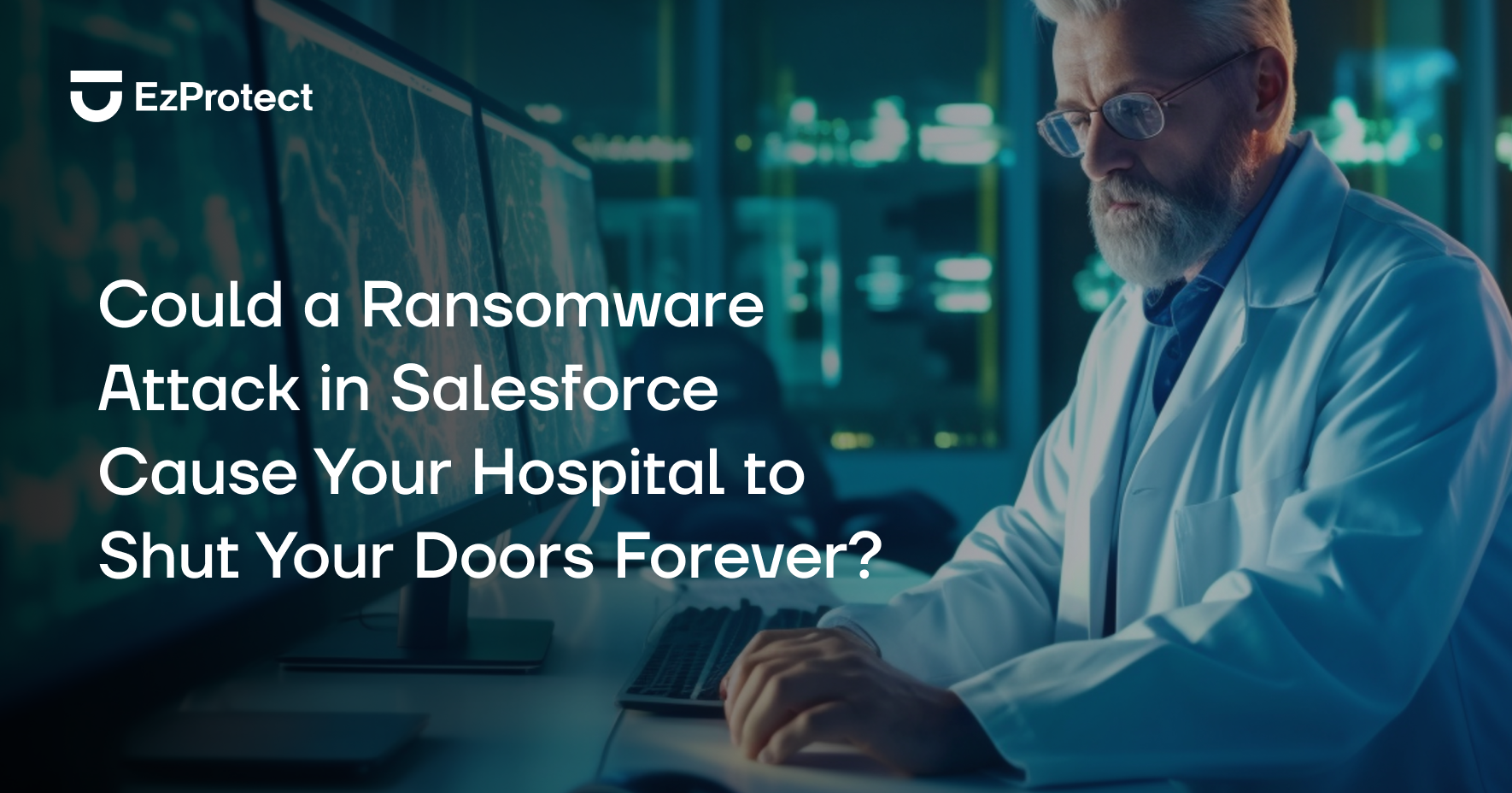Share
Sophisticated ransomware attacks have led to expensive breaches of private data, the disruption of vital infrastructure systems like oil pipelines and mass transit. However, the severity of these attacks is escalating even further as American hospitals and other healthcare institutions are becoming primary targets for ransomware attacks, posing significant risks to human lives and well-being.
Ransomware attacks are carried out by criminal hackers who remotely disable an organization’s computers and demand a ransom for restoration. This costly, embarrassing, and damaging catastrophe is something you should strive to avoid at any expense.
At the University of Vermont Medical Center, an alarming incident occurred where a man battling third-stage cancer, undergoing intense radiation and chemotherapy treatments, was informed that his crucial radiation therapy had been abruptly cancelled for a week due to a ransomware attack that disrupted their systems. This terrifying situation left the man and his family fearing for his life. Regrettably, such experiences are becoming more common, as research indicates that hospitals have become prime targets for ransomware gangs. These cybercriminals exploit vulnerabilities in online networks and demand ransoms to regain control, causing severe disruptions to patient care.
Experts in cybersecurity note that healthcare systems are often ill-prepared to thwart these attacks, despite the very real health risks they pose to patients. Such cyber-attacks have far-reaching consequences, significantly impacting the entire hospital’s functionality. Aside from the drain on resources resulting from paying ransoms to restore operations, the hospital also loses the trust and credibility of patients and their families.
Diminished goodwill can be detrimental to any business and has even led to permanent closure in some cases. For example, St. Margaret’s Health hospital in Illinois had to shut its doors forever due to a devastating ransomware attack.
Emsisoft, a cybersecurity firm, has documented over 25 ransomware attacks on healthcare organizations, including hospitals and multi-hospital health systems, since 2022. These attacks have affected up to 290 hospitals across the country.
Why are hospitals a popular target for ransomware attackers?

1. The loss of sensitive data jeopardizes patient safety.
Hospitals rely on electronic patient data to ensure proper medication administration and surgical procedures. When ransomware encrypts that data, hospitals have no choice to either postpone or cancel surgeries, and have to even move emergency patients to other hospitals or institutions. To avoid this, they frequently perceive ransom payment as the only rational and safe solution.
2. They are potentially profitable targets.
Hospitals are ideal targets for ransomware because attackers believe they can profit greatly from the attack. As a result, when targeting healthcare businesses, terrorists frequently demand bigger ransoms. In response, hospitals perceive paying the ransom as a less expensive choice than reconstructing their systems from the ground up.
3. Obsolete IT infrastructure
Many hospitals continue to employ obsolete technology and operating systems. Because obsolete systems frequently lack security fixes to avoid a future data breach, this ultimately facilitates the cybercriminal’s task. Cybercriminals regularly improve their tools, thus obsolete computers lacking the most recent software patches are doomed in an assault.
4. They do not have backup and recovery plans.
Many healthcare businesses do not back up all of their data and may not have a proper recovery strategy in place. As a result, when an attack occurs, they frequently perceive paying the ransom as the only way out.
5. They are untrained in cybersecurity.
Almost 32% of healthcare employees have never attended workplace cybersecurity training. Rather than giving this training, hospitals concentrate on HIPAA compliance. They are unaware that their information technology systems are only as robust as their weakest employee.
Understanding the Threat of Ransomware Attacks on Salesforce
The Salesforce platform rigorous technical restrictions are not easily breached. However, if a Salesforce environment were to be misconfigured, an attacker could easily take advantage of those misconfigurations to gain access to their data or lock it up with a ransomware attack. You may think that this is something that is not that common, but in reality it is quite the opposite. Salesforce is a very powerful tool, but with that comes complexity. It is far too easy for someone to accidentally click the wrong button, opening up your hospital for attack.
Even if you did everything you could to properly configure Salesforce to secure your data, there are always loopholes that you may have not considered.
For example, Salesforce’s current file upload system lacks a mechanism to scan and detect potential threats in the uploaded files. As a result, any files uploaded to the platform are not being thoroughly screened for harmful content or security risks. This poses a significant concern as it exposes users to potential malware, viruses, or other malicious elements that could compromise the integrity of your data and overall security in Salesforce.
Without a robust scanning process in place, sensitive information and critical data within the uploaded files are vulnerable to exploitation by cybercriminals. This may lead to severe consequences, such as data breaches, unauthorized access to confidential information, or even the spread of malware throughout the organization’s network.
How to protect yourself against the Ransomware attacks in Salesforce
The success of a ransomware attack in Salesforce largely depends on the attackers gaining elevated access to the platform, allowing them to steal data and carry out their nefarious activities.

To safeguard against such potential threats, there are several important steps and you should take:
- Backup Your Salesforce Data: Regularly backing up your Salesforce data is crucial to ensure that, in the event of a ransomware attack or any other data loss incident, you can quickly restore your information to a previous secure state. By maintaining up-to-date backups, you reduce the impact of potential data encryption or deletion caused by ransomware.
- Salesforce Security Health Assessment: Conducting periodic security assessments for your Salesforce environment is essential. These assessments can help identify vulnerabilities and potential entry points that attackers might exploit to gain unauthorized access. By proactively addressing these issues, you can strengthen your security posture and reduce the risk of a successful ransomware attack.
- Virus Scan Files in Salesforce: Implementing security tools like EzProtect can provide an additional layer of defense against ransomware and other threats. EzProtect is designed to scan Salesforce data for potential malware, viruses, or suspicious content. By integrating such scanning mechanisms, you can detect and neutralize threats before they can compromise your Salesforce credentials or sensitive data.
- Enforce Strong Access Controls: Limiting access to sensitive data and administrative privileges is essential to prevent unauthorized users from gaining administrative access to Salesforce. Employing multi-factor authentication (MFA) and least privilege principles can help ensure that only authorized personnel can access critical functions and data.
- Conduct Regular Security Training: Educating your employees and users about common cybersecurity risks, including phishing attempts, can significantly reduce the chances of a successful ransomware attack. Training sessions should emphasize the importance of recognizing and avoiding suspicious emails, links, and attachments.
- Stay Updated with Security Patches: Regularly update and review Salesforce critical updates. Salesforce often release security updates to address newly discovered vulnerabilities. You should review promptly apply these patches to help to minimize potential entry points for attackers.
- Develop an Incident Response Plan: In the unfortunate event of a ransomware attack, having a well-defined incident response plan is crucial. This plan should outline the steps to be taken in the event of a security breach, including how to isolate affected systems, notify stakeholders, involve law enforcement (if necessary), and recover from the attack with minimal disruption.
Wrapping Things Up
By adopting a proactive and comprehensive approach to Salesforce security, hospitals and other health providers can significantly reduce the risk of falling victim to ransomware attacks and other cybersecurity threats.
Early detection and rapid response protocols are vital in maintaining the integrity of your Salesforce data and safeguarding your organization’s operations. EzProtect can help you with a free comprehensive security assessment which will provide you of a more holistic view of the organization’s security landscape and what you should be concerned about.
Contact us today for your risk free security assessment.

Share
Did you love this blog and wish there could be more?
It is our goal to keep you informed about everything you need to know about Salesforce security to keep your Salesforce data and company safe and secure by providing you with the highest quality of original content.
If this sounds good to you, then sign-up below to be one of the first to know when the next super awesome Salesforce security blog has been released.


